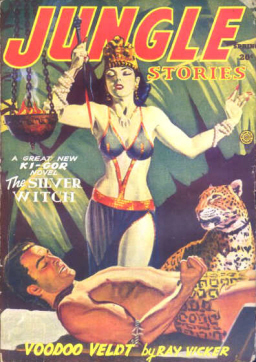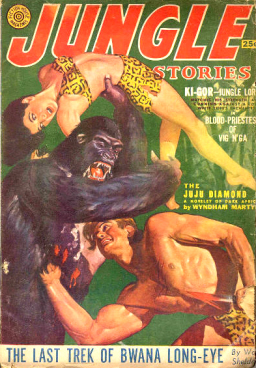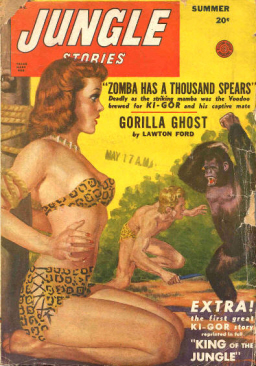Escape to the Jungle
 I’d planned a post about the business of writing today, but when we returned home from a family reunion and I learned about another massacre of innocents by another angry man with a gun, I just couldn’t muster the energy to talk seriously about the trials and tribulations of being a writer. Those trials and tribulations pale before what anyone in the assault was facing.
I’d planned a post about the business of writing today, but when we returned home from a family reunion and I learned about another massacre of innocents by another angry man with a gun, I just couldn’t muster the energy to talk seriously about the trials and tribulations of being a writer. Those trials and tribulations pale before what anyone in the assault was facing.
I couldn’t find much more to add to what I’d already said the last time this happened… what, two weeks ago? My God, people. Surely we can do better than this, somehow.
As a result, today I’m keeping things very light. In graduate school, one of my guilty pleasures was reading some pretty mindless escapist adventure. From the middle to the end of semesters, things could get more than a little hectic, what with all the projects and research papers, and it was nice to be able to just pick up a story and be entertained for a while by my old friend Ki-Gor.
Some years back, at Pulpcon, I missed the chance to become acquainted with the works of the gifted Ben Haas, about a decade before his writing finally hooked me. I didn’t discuss Haas here because most of his best work is western, but I took a long post live on my own site. At the same convention, though, I was wandering around the dealer room with writer John C. Hocking and sword-and-sorcery scholar Morgan Holmes. I stopped to chuckle at a ridiculous-looking pulp cover on display at one of the booths. Jungle Stories was emblazoned upon the masthead. Below, a beautiful and clearly evil dark-haired woman loomed over a bronzed jungle-man bound to an altar. Morgan said, “That’s actually a pretty good story.”
[Click on any of the images in this article for larger versions.]
Knowing that Morgan Holmes is better read on sword-and-sorcery than anyone else in existence, his comment pulled me up short. And then Hocking chimed in as well. “Some of the Ki-Gors are pretty great stuff,” he told me, then added caveats, which I’ll detail in a moment.
 I took the chance and picked up that 1950s issue of Jungle Stories. I wasn’t quite sure what I’d get; but what I didn’t expect was an action-packed adventure with glowing zombie-men who disintegrated into ash when slain, or the machinations of an ageless sorceress intent on… well, I don’t remember what she was intent on, really, but she wanted to conquer something, and she fell for Ki-Gor, hard, as scheming villainesses do. It was corny and ridiculous and over-the-top, and certainly not politically correct. But you had the sense while reading it that the writer had said to himself, “Okay, well, if I’m being hired to write a cliched jungle adventure, I’m going to make it the best cliched jungle adventure I possibly can.” I had stumbled outside of my genre comfort zone and discovered something fascinating. I had to find more Ki-Gor. Who was he, and what about these Jungle Stories? Were they all this much fun, with so many fantasy elements?
I took the chance and picked up that 1950s issue of Jungle Stories. I wasn’t quite sure what I’d get; but what I didn’t expect was an action-packed adventure with glowing zombie-men who disintegrated into ash when slain, or the machinations of an ageless sorceress intent on… well, I don’t remember what she was intent on, really, but she wanted to conquer something, and she fell for Ki-Gor, hard, as scheming villainesses do. It was corny and ridiculous and over-the-top, and certainly not politically correct. But you had the sense while reading it that the writer had said to himself, “Okay, well, if I’m being hired to write a cliched jungle adventure, I’m going to make it the best cliched jungle adventure I possibly can.” I had stumbled outside of my genre comfort zone and discovered something fascinating. I had to find more Ki-Gor. Who was he, and what about these Jungle Stories? Were they all this much fun, with so many fantasy elements?
It goes without saying that without Tarzan, there would be no Ki-Gor. The blond-haired jungle-man was crafted to meet the tastes of a public with an insatiable appetite for the adventures of Burroughs’s hero. Ki-Gor was not the first Tarzan clone, but he seems to have sustained the longest known run of any of Burroughs’s imitators. This was partly because there was money behind Jungle Stories, the pulp that printed the adventures of Ki-Gor for close to 17 years, from 1938 to 1954. For most of that run, readers could head to their local newsstand once every quarter and find the mighty Ki-Gor emblazoned across the cover wrestling a giant snake or a lion or an angry native, while his gorgeous “flame-haired” wife posed nearby in a two-piece leopard-skin bikini (frequently bound and sometimes gagged, which has made the covers popular amongst another set of collectors).
Each issue of Jungle Stories opened with a Ki-Gor “novel” (meaning a piece that came in between 20 and 40 thousand words) backed up by shorter stories of unrelated characters. Ki-Gor was the magazine’s real draw, and his escapades backed up the promise of the covers, for there were dangers aplenty to be overcome by the jungle lord. The prose was purple, the action relentless, and cliffhangers closed almost every section.
While on the surface Ki-Gor sounds very much like any other Tarzan-inspired pastiche, he often rose above his humble origins. Written as he was by a house name, the true authors of Ki-Gor’s chronicles are little known, which is why we can’t be sure why a number of them are so much better than they really deserve to be. Close to a third of Ki-Gor’s adventures stand head-and-shoulders above the rest. The prose is tighter, the characters deeper, the setting more vivid – and frequently more bizarre — than almost anything Burroughs ever cooked up for Tarzan. The best of them crackle with the kind of energy visitors to the old pulp mags expect and almost never find. The worst though, ye Gods. They can be stinkers.
 Under different hands, all the characters fare differently, but none so much as Tembu George, Ki-Gor’s friend and chief of a tribe of Massai warriors. In the good Ki-Gors, Tembu George is brave, resourceful, and way WAY cooler than you’d think any black man would be in a 1950s magazine aimed at white men. Ki-Gor risks life and limb for Tembu George and his pygmy friend, N’Geeso, more times than you can count, and those two always reciprocate. (On the other hand, Ki-Gor’s a white guy who’s better than these black guys at jungle stuff, so… but remember what I said the other week about genre conventions and prejudices?)
Under different hands, all the characters fare differently, but none so much as Tembu George, Ki-Gor’s friend and chief of a tribe of Massai warriors. In the good Ki-Gors, Tembu George is brave, resourceful, and way WAY cooler than you’d think any black man would be in a 1950s magazine aimed at white men. Ki-Gor risks life and limb for Tembu George and his pygmy friend, N’Geeso, more times than you can count, and those two always reciprocate. (On the other hand, Ki-Gor’s a white guy who’s better than these black guys at jungle stuff, so… but remember what I said the other week about genre conventions and prejudices?)
Approximately 59 Ki-Gor novellas were published during the run of Jungle Stories. The number is inexact because later in its run, Jungle Stories sometimes re-used covers (upon which a novella title was already emblazoned) and printed a new story using the same name. Sometimes Jungle Stories reprinted the original story, and sometimes it reprinted a different story while reprinting an unrelated cover. The circumstances have led to some confusion about the precise number of stories, and which story has which title. Despite that, it’s possible to safely make several generalizations.
The first three or four years of Ki-Gor, from 1938 to 1941, sound quite dated. Ki-Gor himself isn’t especially clever and the natives are embarrassingly non-pc. After the 13th issue, Ki-Gor began to take on an easy nobility of spirit and his loyal native friends started to demonstrate both independence of thought and real capability. By Ki-Gor’s sixth year of existence, and for many years thereafter, this portrayal became more the norm than the exception, until Jungle Stories lost steam and direction. Lesser Ki-Gors dropped into the mix more and more frequently, and Ki-Gor’s final years were less inventive.
In all, there are some 15 to 20 good Ki-Gors. Not good in a Proust sense, or good in a unique Tolkien or Jack Vance world-building sense, but good as grand pulp adventures. In them, one can find lost civilizations, evil queens, ancient temples and curses, noble friends, evil schemes, monsters from the dawn of time, mad scientists, telepathy, battles against overwhelming forces, supernatural menace, and above all action with a capital A. Hocking described the good ones as sounding a little like Robert E. Howard or Mickey Spillane writing a Tarzan story. They tend to recycle themes — Helene captured, a lost ancient civilization still existing in the jungle, Ki-Gor framed — but when they’re not read back to back, they’re loopy fun. THIS time, Ki-Gor must save his wife and native women from marauding cave men freed from an ancient valley! THIS time, Ki-Gor must stop a horde of vampiric flying squirrels, commanded by a beautiful telepathic Indian (no, I’m not kidding).
The “good” ones are enough fun that people like Hocking and Andy Beau and I slogged our way through a mountain of bad ones looking for more gold. You don’t need to think a whole lot about these tales, which made them great for reading in the middle of my grad school studies. If a few days had gone by since I’d had time to read and I’d forgotten what page I was on, it didn’t matter. I’d discover Ki-Gor in the middle of a fight with a crocodile, or Tembu George in furious combat with his shovel-bladed Massai spear, and sit back and enjoy.
Ki-Gor’s getting a little easier to find these days. There are a whole series of reprints courtesy of High Adventure, and, for the completists, Altus Press is compiling the entire run. They’re currently up to volume 2. For the truly curious, I’ve listed my very favorite Ki-Gor stories on my own web site so you don’t have to slog through the truly awful ones like the rest of us intrepid explorers.
Howard Andrew Jones is the author of the historical fantasy novels The Desert of Souls, and the forthcoming The Bones of the Old Ones, as well as the related short story collection The Waters of Eternity, and the Paizo Pathfinder novel Plague of Shadows. You can keep up with him at his website, www.howardandrewjones.com, and keep up with him on Twitter or follow his occasional meanderings on Facebook.
[…] at Black Gate today I waxed on about the peculiar glories of the adventures of Ki-Gor in old Jungle Stories magazine. My friend […]
While the worst Ki-Gor novels are poor enough to be painful to read, the best ones are so good as to make wading through the bad ones worthwile.
What the good ones have going for them is a little hard to explain to someone who isn’t a pulp fan. They aren’t classy or clever, and they are emphatically not original.
At their pinnacle what they have is a blazing enthusiasm for formula so intense that you could be forgiven for imagining the unknown author leaping up wild-eyed from his smoking typewriter, flailing his arms and leaping around his garrett in a frenzy of unleashed prose composition.
Jungle Stories collectors have generally agreed that Stalkers of the Dawn World is the best Ki-Gor novel, and although there are others I like as much, this may be the best example of what I’m trying to get at here.
Stalkers of the Dawn World is your basic ‘Jungle Man Rescues Lost Safari in a Valley of Dinosaurs’ story. You could probably parse out the whole plot in a few moments even if your entire experience with jungle pulp storytelling was drawn from watching a couple Tarzan movies. Doesn’t matter.
The novel is written in a virtual typhoon of the most outrageously purple prose. Simple descriptions of the jungle attain ecstatic heights while actual scenes of action (including the inevitable climactic showdown between Ki-Gor and a T. Rex), go so far over the top as to qualify as some kind of controlled substance in prose form.
Obviously, this is the kind of thing that people who like that kind of thing are really going to like. A real high point for latter day pulp sensationalism.
> the machinations of an ageless sorceress intent on… well, I don’t remember what she was intent on, really,
> but she wanted to conquer something, and she fell for Ki-Gor, hard, as scheming villainesses do.
Dr. Jones, you bust me up.
I even wrote about that fateful encounter at Windy City 2006, when you loaned me a Ki-Gor reprint of “The Silver Witch,” in my BG 10 editorial. Good times, good times.
Then you wanted it back before I’d read it, just because I’m backlogged a year or two on my leisure reading. Some friend you are.
Man, I love those covers, too. You have good taste, Dr. Jones.
Can I have the reprint back now?
Fortunately, fans of loopy and not-so-loopy jungle action can also read NEW Ki-Gor adventures: Jungle Tales Vol.1 features three new Ki-Gor tales. The plots fit the great descriptions Howard provides: in “The Path of Life and Death,” our hero battles cannibals to save a jungle queen; in “The Secret of the Vikings,” KG meets — guess who?– in a hidden valley; and in my story, “The Devil’s Nest,” KG seeks an heir to a fortune who’s lost in the Congo, encountering a born-again cannibal, baseball, mercenaries seeking the gold of Ophir, and dinosaurs! More loopy than you can shake a spear at.
[…] Escape to the Jungle […]
[…] all but forgotten. I have three more books to go (and a fifth to track down). I have a handful of Ki-Gor novellas left. It still seems incredible to me that I could enjoy jungle-man adventures so much, but the […]
[…] site. In the past I’ve described the purple pulp glories of Tarzan clone Ki-Gor both at Black Gate and here on the site. Well, feast your eyes upon this. The aforementioned British site has scans of […]
[…] You want something completely different? One of the ways I kept sane through grad school was by reading the jungle tales of Ki-Gor from the old pulp Jungle Stories. Here’s why. […]